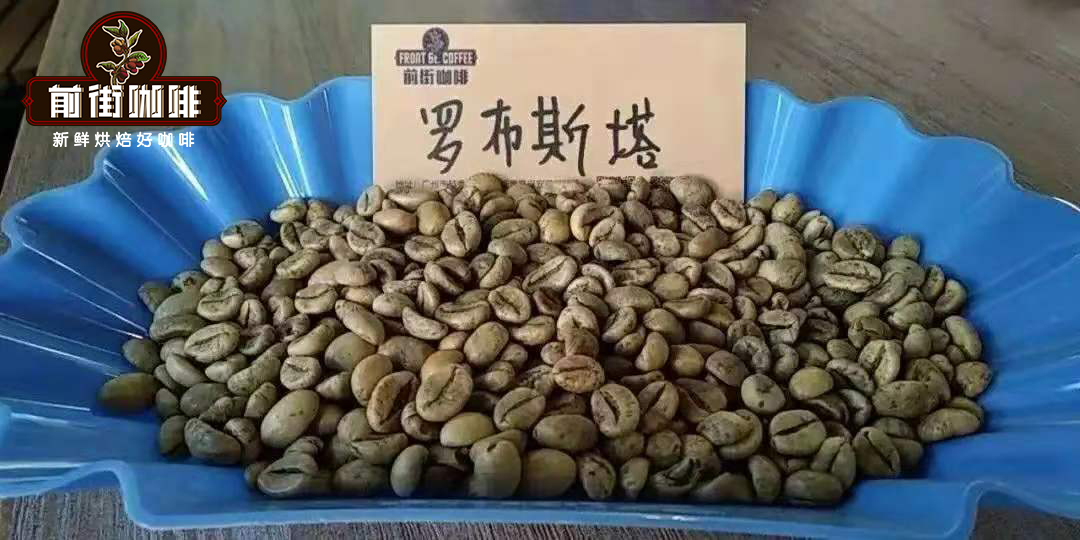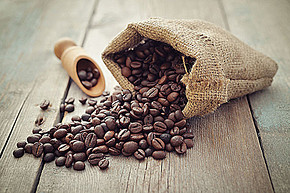How to drink robusta coffee powder after the name of robusta coffee
Follow the caf é (Wechat official account vdailycom) and found that Beautiful Cafe opened a small shop of its own.
People always habitually look at things in dichotomy, good and bad, good and evil, good and bad. The same is true in the world of coffee. "arabica" coffee beans are always classified as "good", while its distant relative "Robusta" coffee beans are often classified as "bad". We may describe it this way: if Arabica is a gift from angels, Robusta is like the booger of the devil, always despised and spurned by coffee gluttons.
Why is Robusta so notorious? Robusta beans, which are round in appearance and look like soybeans at first glance, are also known as thick and strong beans. They have strong resistance to diseases and insect pests, large output and low price. The boutique coffee industry used to have a very poor impression of Robusta because it usually does not have a charming and meticulous flavor. The bigger problem is that because the setting is a low-cost product, most of the planting methods are very rough, resulting in a bad smell. It often smells like dirt, dirt, and sometimes even a smell like charred tires and burning plastic. Ten years ago, I had a chance to taste several cheap Vietnamese robusta beans, some of which were unforgettable because they were like charred wheat tea flavored with tires, and I couldn't help spitting them out with the other nine bad flavors. I don't want another sip.

Wow! If Robusta beans are so bad, why talk about it? That's a good question! As mentioned at the beginning of this article, everything has its advantages and disadvantages. Good beans take you to heaven, rotten beans let you hang your heart! This is true of Arabica, and Robusta is no exception! In fact, under the tide of boutique coffee in recent years, exquisite robusta beans with high standard treatment have appeared in the world! The representative of boutique India Kappi Royale beans is India's Robusta (Robusta "Kappi Royale" Robusta).
Kappi Royale means "top grade". At present, there are at least four (and growing) private coffee farms in India to grow and produce high-quality "Coffee Royal" and "Kappi Royale" Robusta coffee beans with refined Arabica standards and procedures! It includes exquisite full water washing treatment and Pulp Natural mucosal drying semi-washing treatment which is popular in recent years. The advent of the "Coffee Royal" grade exquisite Robusta beans has undoubtedly begun to change the world's impression of Robusta! Most people who have drunk it will be surprised by its thick and clean characteristics. Because of the exquisite planting and handling procedures, the flavor of the Royal Coffee Robusta is mostly quite clean, without the intrusive flavor of the cheap Robusta (off-flavors). The Robusta is born without the elegant aroma of Arabica beans, replaced by a thicker, calmer taste, as well as strong walnut, peanut, hazelnut and wheat flavors like peanut butter and hazelnut.
India's "Coffee Royal" grade Robusta currently produces very little, but it has begun to attract the attention of the elite of the boutique coffee industry all over the world. Italian coffee expert David Schumann C. Schomer's famous Seattle-based Espresso Vivace began adding 14% of India's "Royal Coffee" Robusta to its Italian formula beans as early as a decade ago. Paradise Roasters, the national coffee evaluation points champion roaster, took the lead in the North American boutique coffee market, launching 100% Indian CxR espresso in 2009, and received a Coffee Review rating of 90 and 91 points in 2009 and 2010! It proves that Robusta is not what it used to be!
Incidentally, the price of Robusta is not cheap, even more expensive than many Elaraby beans! So, from now on, please stop saying: Robbins are rotten beans-after all, times have changed! With the emergence and gradual attention of high-quality Robusta, it is bound to cause some chain reactions and changes to the boutique coffee culture (to be continued).
Note: David C.Schomer cancelled the addition of Robusta beans to 100% arabica formula in the second quarter of 2009.
If you want to ask the country or region that loves Robusta beans most, the first place is Italy, the hometown of espresso! If you narrow it down, to be more precise, the largest use of robusta beans is in southern Italy, such as Palermo, Naples and Sicilia. In fact, in southern Italy, most of the coffee people drink contains a considerable proportion of robusta beans. The content of 30% to 60 is commonplace, and the Robusta content of some formula beans is as high as 80% or even 100%!
Open the table of beans supplied by local wholesalers of raw coffee beans in Italy, and you will see a list of more than a dozen, or even as many as two dozen, raw beans from all over the world, for local coffee roasters to choose from. This phenomenon does not exist in other parts of the world, such as the United States and Canada, Northern Europe, Japan and even Taiwan.
You may wonder why the Italians mix a lot of robusta in Arabica beans. Generally speaking, Italian people blend into Robusta in order to increase the Crema content of Espresso.
This is only half true, and there is another little-known reason.
It turned out that southern Italy used to be a relatively poor region, where people could only afford cheap coffee, so at first it was mixed with Robusta beans simply to reduce costs. However, after years of massive baking and blending of Robusta, coupled with Italy's natural sensitivity to cooking, they found that Robusta beans have many qualities that Arabica beans do not have. as long as you are familiar with and fully master these qualities, a good cook (coffee roaster) will be able to serve magical dishes (Italian coffee beans). Compared with 44 pairs of chromosomes in Arabica beans, Robbosa beans have only 22 pairs of chromosomes, with caffeine contents of 1.5% and 2.8%, respectively. The two are completely different varieties and cannot be mixed, which explains why there are many complete differences between the two.
I like to say that Arabica beans are like earthlings, which are easy to see and familiar to us. Rob Tadou is like an alien, although it has the appearance of being close to the people on earth, but it is actually completely different on the inside. Earthlings and aliens have their own advantages and disadvantages, and each has its own advantages and disadvantages. Although they are different races and cannot marry to have children, through exquisite arrangements, putting them together cleverly to make up for their weaknesses and full cooperation, they will be able to contribute their respective strengths and excite an amazing spark!
I was born to be useful. Robusta and Arabica are both gifts from angels, the difference is only in the use of people.
Important Notice :
前街咖啡 FrontStreet Coffee has moved to new addredd:
FrontStreet Coffee Address: 315,Donghua East Road,GuangZhou
Tel:020 38364473
- Prev

Flavor and taste characteristics of robusta coffee varieties growth and environment of robusta coffee beans
Following caf é (Wechat official account vdailycom) found that Arabica Coffee beans grow at colder high elevations in the tropics, while high temperatures and low elevations, which are not suitable for Arabica varieties, are home to Robusta. Robusta grows in lowlands 200-600 meters above sea level. He likes a warm climate and requires a temperature of
- Next

Medium fruit coffee robusta coffee
Follow Cafe (Wechat official account vdailycom) found that Beautiful Cafe opened a small shop of its own Robusta species (scientific name Coffee Robusta Linden). The leaf rust-resistant varieties found in Congo in Africa have stronger disease resistance than Arabica. In the general coffee market, many people like to compare robusta coffee beans with Arabica coffee beans, which is incorrect.
Related
- Detailed explanation of Jadeite planting Land in Panamanian Jadeite Manor introduction to the grading system of Jadeite competitive bidding, Red bid, Green bid and Rose Summer
- Story of Coffee planting in Brenka region of Costa Rica Stonehenge Manor anaerobic heavy honey treatment of flavor mouth
- What's on the barrel of Blue Mountain Coffee beans?
- Can American coffee also pull flowers? How to use hot American style to pull out a good-looking pattern?
- Can you make a cold extract with coffee beans? What is the right proportion for cold-extracted coffee formula?
- Indonesian PWN Gold Mandrine Coffee Origin Features Flavor How to Chong? Mandolin coffee is American.
- A brief introduction to the flavor characteristics of Brazilian yellow bourbon coffee beans
- What is the effect of different water quality on the flavor of cold-extracted coffee? What kind of water is best for brewing coffee?
- Why do you think of Rose Summer whenever you mention Panamanian coffee?
- Introduction to the characteristics of authentic blue mountain coffee bean producing areas? What is the CIB Coffee Authority in Jamaica?

